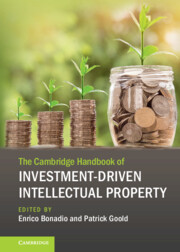Book contents
- The Cambridge Handbook of Investment-Driven Intellectual Property
- The Cambridge Handbook of Investment-Driven Intellectual Property
- Copyright page
- Contents
- Figures and Tables
- Contributors
- Foreword
- Introduction
- I Creativity, Pluralism, and Fictitious Narratives
- Part I Science, Technology and Industry
- Part II Culture and Entertainment
- Part III Signs, Images and Designs
I - Creativity, Pluralism, and Fictitious Narratives
Understanding IP Law through Karl Polanyi
Published online by Cambridge University Press: 16 March 2023
- The Cambridge Handbook of Investment-Driven Intellectual Property
- The Cambridge Handbook of Investment-Driven Intellectual Property
- Copyright page
- Contents
- Figures and Tables
- Contributors
- Foreword
- Introduction
- I Creativity, Pluralism, and Fictitious Narratives
- Part I Science, Technology and Industry
- Part II Culture and Entertainment
- Part III Signs, Images and Designs
Summary
In the 2021 best-seller Exponential,2 Azhar explores social evils that will invariably result from exponential technological leaps such as excessive resource extraction, destabilization of social, economic and political institutions, and the dramatic rise of corporate power in societal and economic terms. Like Polanyi, he fixes the industrial revolution as the point of genesis of current social problems. And, akin to the Polanyian ‘double movement’, Azhar suggests that a dystopian world is not inevitable if we accept the vital importance of institutional norms – such as the rule of law or international intellectual property (IP) agreements – in protecting the social and economic fabric of humanity. Reform, he argues, should lie in forging new customs and norms based on collective ownership and commonality principles such as interoperability. Or even in instituting a global data body which creates ‘a consistent approach towards artificial intelligence, citizens’ data and intellectual property’.3 This chapter is a simpler narrative which nevertheless suggests, as Azhar does, that the solution to IP conundrums lies in the recognition that global IP norms are vital and that their reformation must be in accordance with societal motivations.
- Type
- Chapter
- Information
- Publisher: Cambridge University PressPrint publication year: 2023



